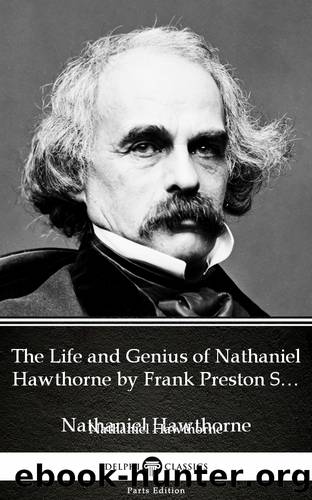The Life and Genius of Nathaniel Hawthorne by Frank Preston Stearns by Nathaniel Hawthorne--Delphi Classics (Illustrated) by Nathaniel Hawthorne

Author:Nathaniel Hawthorne [HAWTHORNE, NATHANIEL]
Language: eng
Format: epub
Tags: Parts Edition 29 of 34 by Delphi Classics
Publisher: Delphi Classics (Parts Edition)
Published: 2017-08-12T00:00:00+00:00
CHAPTER XII. â THE LIVERPOOL CONSULATE: 1852-1854
Why Hawthorne returned to Concord in 1852 is more of a mystery than the suicide of Zenobia. Horace Mann also left Newton, to be President of Antioch College (and to die there in the cause of feminine education), in the autumn of that year; but this could hardly have been expected six months earlier. Hawthorne was not very favorably situated at Newton, being rather too near the railroad; but there was plenty of land on the top of the hill, where he might have built himself a house, and in the course of twelve years his property would have quadrupled in value. A poet will not be less of a poet, but more so, for understanding the practical affairs of life. Or he might have removed to Cambridge, where Longfellow, always foremost in kind offices, would have been like a guardian angel to him, and where he could have made friends like Felton and Agassiz, who would have been much more in harmony with his political views. Ellery Channing was the only friend he appears to have retained in Concord, and it was not altogether a favorable place to bring up his children; but the natural topography of Concord is unusually attractive, and it may be suspected that he was drawn thither more from the love of its pine solitudes and shimmering waters, than from any other motive.
The house he purchased was nearly a mile from the centre of the town, and has ever since been known by the name of the Wayside. After Hawthorneâs return from Europe in 1860, he remodelled it somewhat, so that it has a more dignified aspect than when he first took possession of it. Alcott, who occupied it for some years previously, had adorned it with that species of rustic architecture in which he was so skilful. The house was half surrounded by a group of locust trees, much in fashion seventy years ago, and had been set so close against the hill-side, that a thicket of stunted pines and other wild growth rose above the roof like a crest. Bronson Alcott was his next-door neighbor, â almost too strong a contrast to him, â and Emersonâs house was half a mile away; so that these three families formed a group by themselves in that portion of Concord.
Hawthorne wrote a letter to his sister Elizabeth, describing his new acquisition, and expressing satisfaction in it. It was the first house that he had ever owned; and it is no small comfort to a man to live under his own roof, even though it be a humble one. At this time, however, he did not remain at the Wayside but a single year. After that, the house stood empty until the untimely death of Horace Mann, August 2, 1859, when Mrs. Mann came to Concord with her three boys, and occupied it until Hawthorneâs return from Europe.
{Illustration: THE WAYSIDE}
It may as well be noticed here, that, during the eight years
Download
This site does not store any files on its server. We only index and link to content provided by other sites. Please contact the content providers to delete copyright contents if any and email us, we'll remove relevant links or contents immediately.
Evelina by Fanny Burney(25996)
Evelina, Or, the History of a Young Lady's Entrance into the World by Fanny Burney(25769)
Twilight of the Idols With the Antichrist and Ecce Homo by Friedrich Nietzsche(17748)
Pale Blue Dot by Carl Sagan(4051)
Dune 01 Dune by Frank Herbert(3861)
The Perks of Being a Wallflower by Stephen Chbosky(3856)
Man and His Symbols by Carl Gustav Jung(3352)
Double Down (Diary of a Wimpy Kid Book 11) by Jeff Kinney(3312)
Separate Beds by LaVyrle Spencer(3295)
Walking by Henry David Thoreau(3259)
FOUNDATION AND EMPIRE by Isaac Asimov(3199)
The 101 Dalmatians by Dodie Smith(2963)
Anna and the French Kiss by Stephanie Perkins(2913)
Ficciones by Jorge Luis Borges(2894)
Mystery at School by Laura Lee Hope(2840)
120 Days of Sodom by Marquis de Sade(2467)
Some Prefer Nettles by Tanizaki Junichiro(2466)
The Little Prince by Antoine de Saint-Exupéry(2369)
My Ántonia by Willa Cather(2353)
